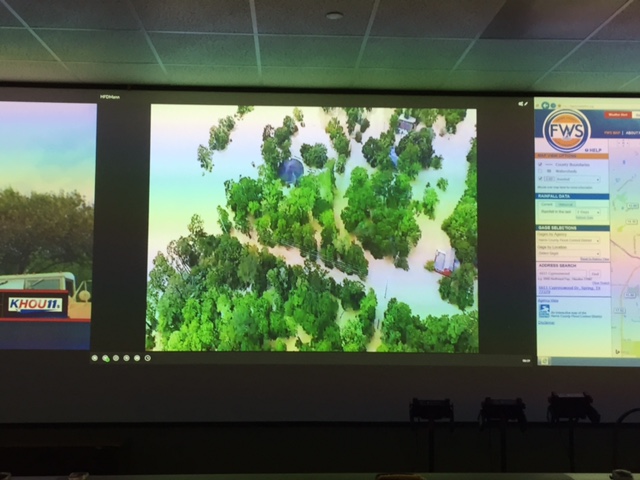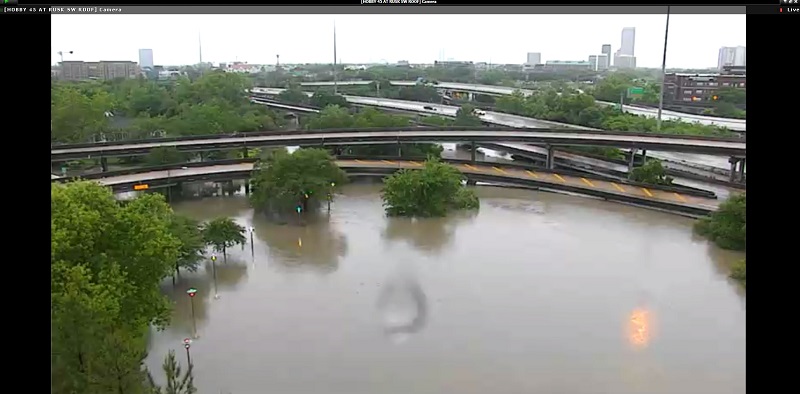When torrential storms caused widespread flooding in Houston, Texas, in mid-April, first responders needed a way to securely share information amongst their many organizations. Luckily the Science and Technology Directorate (S&T) First Responders Group’s (FRG) datacasting system was available. Datacasting provides public safety users with the capability to transmit secure video and data over existing broadcast television signals to a targeted audience. Even in an emergency situation, where other wireless services often fail due to network congestion, datacasting still provides a reliable platform to quickly send large files.
 “Datacasting is a broadcasting mechanism capable of one-to-many content delivery which reduces congestion on public safety agencies’ networks,” said FRG Program Manager Cuong Luu. “This vastly impacts how video and data is currently shared by responders, providing better collaboration, and continuing to leverage current infrastructure costs of the public broadcast television stations.”
“Datacasting is a broadcasting mechanism capable of one-to-many content delivery which reduces congestion on public safety agencies’ networks,” said FRG Program Manager Cuong Luu. “This vastly impacts how video and data is currently shared by responders, providing better collaboration, and continuing to leverage current infrastructure costs of the public broadcast television stations.”
When broadcast television transitioned from analog to digital broadcast transmissions, it created the opportunity to allocate the television spectrum in new ways. Datacasting takes advantage of a portion of the public broadcasting station’s bandwidth normally used for television programming, resulting in this technology being available to public safety organizations at a low cost and low stress to the systems.
The Houston Fire Department recently used the tool to survey flooded areas during the storms affecting the city. A helicopter sent to monitor the scene did not have an on-board camera or video streaming capability. Officials on duty quickly solved this problem using a new datacasting tool – a smartphone app. This app allows users to capture, upload and securely send live video footage and images from any location using a mobile device through the datacasting system. This capability helps first responders effortlessly communicate, providing situational awareness and access to information they need to make informed decisions when responding to an incident.
The footage captured from the helicopter was displayed in the Emergency Operations Center and shared with city leaders via a laptop, giving them the ability to quickly evaluate affected areas and strategize further response efforts. Those viewing the footage thought it was transmitted by one of the camera-equipped helicopters and were shocked to learn a smartphone had transmitted the images.
Rick Flanagan Houston’s Emergency Manager commented on the ease of using datacasting from a phone, “All you have to do is download the app, push a button, and you can have an integral part in capturing critical information.”
 This was the first major incident during which the City of Houston used the tool without support from the datacasting team on hand. The successful utilization of the tool without the datacasting support team on site reflects an effective and efficient technology transfer effort by FRG, Johns Hopkins University Applied Physics Lab, and subcontractor SpectraRep.
This was the first major incident during which the City of Houston used the tool without support from the datacasting team on hand. The successful utilization of the tool without the datacasting support team on site reflects an effective and efficient technology transfer effort by FRG, Johns Hopkins University Applied Physics Lab, and subcontractor SpectraRep.
Datacasting was also successfully used earlier this year by the City of Houston with the assistance of the datacasting team during a Republican presidential candidate debate and the NCAA Men’s Final Four Basketball Tournament.
Jack Hanagriff of Houston’s Office of Public Safety and Homeland Security commented, “This software is giving us the ability to quickly and easily accommodate needs and fill capability gaps with minimal strain on our resources.”
S&T is currently looking to identify other potential public safety partners and pilot locations for 2016 to test additional capabilities. Interested responders should send an email to first.responder@hq.dhs.gov . Click here to learn more about the project.
